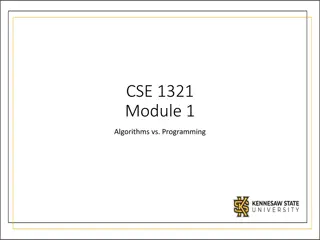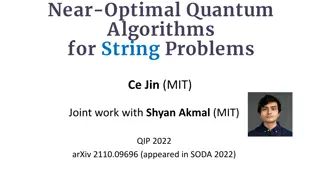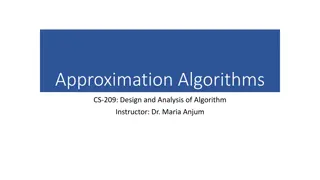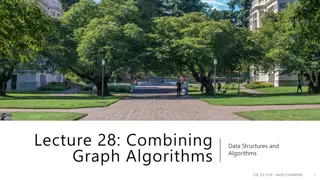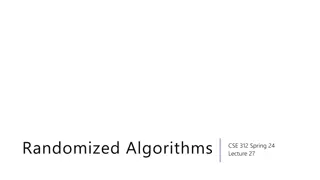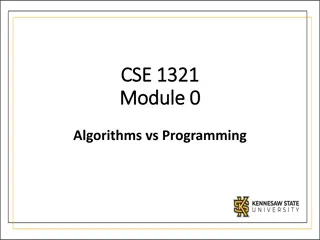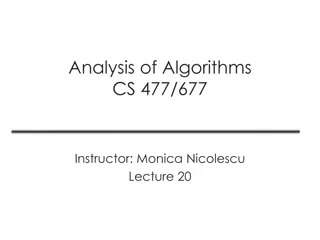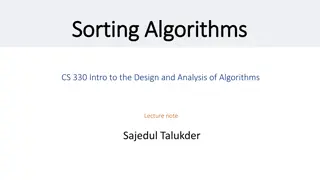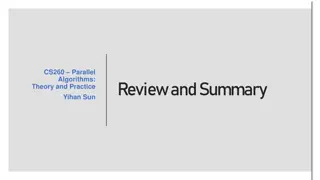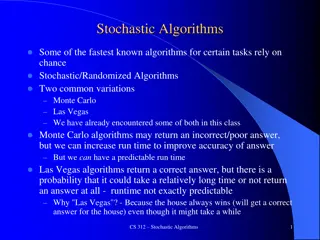Introduction to Analysis of Algorithms
Analysis of Algorithms involves determining the efficiency of algorithms by computing the time needed to solve a problem. Time complexity is a key factor, denoted by functions like t(n) or f(n), where n represents the input size. Asymptotic Growth focuses on the behavior of time complexity for large input sizes, as small inputs have negligible impact. The running time of algorithms can vary significantly based on the size of the input. Understanding time complexity is crucial for assessing algorithm efficiency.
Download Presentation

Please find below an Image/Link to download the presentation.
The content on the website is provided AS IS for your information and personal use only. It may not be sold, licensed, or shared on other websites without obtaining consent from the author.If you encounter any issues during the download, it is possible that the publisher has removed the file from their server.
You are allowed to download the files provided on this website for personal or commercial use, subject to the condition that they are used lawfully. All files are the property of their respective owners.
The content on the website is provided AS IS for your information and personal use only. It may not be sold, licensed, or shared on other websites without obtaining consent from the author.
E N D
Presentation Transcript
Introduction to Analysis of Algorithms
Analysis of Algorithms To determine how efficient an algorithm is we compute the amount of time that the algorithm needs to solve a problem. Given two algorithms for the same problem, the preferred one is the faster. 1-2 1-2
Time Complexity The time complexity of an algorithm is a function that gives the amount of time that the algorithm takes to complete. The time complexity depends on the size of the input, or the number of data items in the input. 1-3 1-3
Time Complexity The time complexity of an algorithm is denoted as t(n) or f(n), where n is the size of the input. The time complexity is non-decreasing in the size of the input, i.e. the amount of time needed by an algorithm cannot decrease as the size of the input increases. (For example, copying a large array cannot take less time than making a copy of a smaller array.) 1-4 1-4
Asymptotic Growth Let t(n) = 15n2 + 45 n be the time complexity of an algorithm. For each value of n the function indicates the amount of time required by the algorithm. So t(1) is the running time of the algorithm when the input has 1 data item, t(100) is the running time of the algorithm when the input has 100 data items, and so on. 1-5 1-5
The following table shows the value of the above function t(n) for various values of n. Assume that the times are given in microseconds (1 microsecond = 0.000001 second) No. of items n 15n2 45n 15n2 + 45n 1 2 5 10 15 60 375 1,500 45 90 225 450 60 150 600 1,950 100 1,000 10,000 150,000 15,000,000 1,500,000,000 4,500 45,000 450,000 154,500 15,045,000 1,500,450,000 100,000 150,000,000,000 4,500,000 150,004,500,000 1,000,000 15,000,000,000,000 45,000,000 15,000,045,000,000 1-6
Asymptotic Growth When trying to decide whether an algorithm is efficient we are only interested in the value of its time complexity for large values of n, because for small values of n the running time of an algorithm is very small. (For example, in the previous table, for values of n smaller than 100 the running times are much smaller than 1 second. However, for n = 1 million, the running time of the algorithm is 173 days.) 1-7
Asymptotic Growth For large values of n, the value of the time complexity function is mainly determined by the largest term in the function. For example, for the above time complexity t(n) = 15n2 + 45n the largest term is 15n2. Notice that for large values of n, the value of 15n2 is much bigger than the value of 45n. We say that 15n2 asymptotically dominates 45n and so that t(n) has the same asymptotic behaviour as 15n2. 1-8
Big-Oh Notation There is a mathematical notation called the order or big-Oh notation for expressing the asymptotic growth of a time complexity function. A formal definition for the big-Oh notation will be given in the second year course on data structures an algorithms. The big-Oh notation captures the running time of an algorithm independently of how it is implemented and executed, i.e., independently of the programming 1-9 1-9
Big-OhNotation language in which it is implemented, of the computer in which it is run and of the operating system used by such a computer. Roughly speaking, since different computers differ in speed by a constant factor (a factor that does not depend on the algorithm being executed and the size of the input on which the algorithm operates), when expressing the asymptotic growth of a time complexity 1-10 1-10
Big-Oh Notation function using the big-Oh notation, any constant factors in the function are ignored. So, for example the time complexity function t(n) = 15n2 + 45n, grows asymptotically as fast as 15n2, which in big- Oh notation is denoted as O(n2) since, as explained above, the constant factor 15 is ignored. A factor is constant if its value does not depend on the size of the input. (Note that 15 does not depend on n.) 1-11 1-11
Big-Oh Notation The asymptotic growth of the time complexity function of an algorithm is referred to as the order of the time complexity of the algorithm. Example: O(n2) means thatthe time taken by the algorithm grows quadratically as n increases O(1) means constant time, independent of the size of the input 1-12 1-12
Big-Oh Notation Given a time complexity function of the form t(n) = t1(n) + t2(n) + + tk(n) Where the number k of terms is constant (i.e. independent of n) the order of t(n) is determined by the largest term ti(n). Some examples of computing the order of several functions are given in the next page. 1-13 1-13
Determining Time Complexity When computing the time complexity of an algorithm, we focus our attention on the most expensive parts of the algorithm, namely the loops and the recursive calls. We will look at recursive calls later, for now we will look at how to compute the time complexity of loops. 1-14
Determining Time Complexity The time complexity function of an algorithm gives the running time of the algorithm. From just the description of an algorithm we cannot determine the amount of time, say in seconds, that it would need to execute. So, how can we determine the time complexity of an algorithm like this one? x = 0; for (int i = 0; i < n; i++) x = x + 1; 1-15
Determining Time Complexity When analyzing an algorithm we cannot determine its actual running time, but we can estimate it if we count the number of basic or primitive operations that the algorithm performs. A basic or primitive operation is an operation that takes constant time (i.e. independent of the size of the input). Some examples of primitive operations are: assigning a value to a variable, comparing the values of two variables and adding two values. 1-16
Analysing Loop Execution For the algorithm below, the primitive operations are =, <, ++, +. Outside the loop one operation is performed (=). In each iteration of the loop four operations are performed (<, ++, =, +). Since the loop is repeated n times, the total number of operations performed is 4n+1. Roughly speaking, this means that the running time of the algorithm is proportional to 4n+1. The order of the function 4n+1 is O(n) and so is the order of the time complexity of the algorithm. x = 0; for (int i=0; i<n; i++) x = x + 1; 1-17 1-17
Time Complexity Since the number of primitive operations performed by an algorithm and the time complexity of the algorithm have the same order, we can say that the time complexity of an algorithm is the same as the number of primitive operations that it performs. So, for the algorithm above we say that its time complexity is t(n) = 4n+1. Note that we are not really interested in the exact value of this function, but we only wish to know the order of the time complexity. So we say that the above algorithm as time complexity O(n). Notice that since any constant factors in the time complexity function are ignored when computing the order of the time complexity, we do not need to count 1-18 1-18
exactly the number of primitive operations performed by the algorithm. For example, for the same algorithm above We can say that each iteration of the for loop performs a constant number k of operations. Since the loop is repeated n times, the total number of operations performed by the for loop is kn. Outside the loop a constant number k of additional operations are performed, so the total number of operations performed by the algorithm is kn + k , which is O(n). Note that we obtained the same result, namely that the time complexity is O(n) even though we did not count the exact number of operations. x = 0; for (int i=0; i<n; i++) x = x + 1; 1-19
However, we need to be very careful when counting the number of iterations of any loop, as a wrong value for the number of operations might lead to the wrong order for the time complexity. Nested loops When computing the time complexity of an algorithm with nested loops, like the algorithm below, we usually consider the innermost loop first and work our way outward. for (int i=0; i<n; i++) { x = x + 1; for (int j=0; j<n; j++) y = y 1; } 1-20 1-20
Each iteration of the inner loop performs a constant number k of operations. Every time that the loop is performed, it iterates n times (as j takes values 0, 1, , n-1), therefore the total number of operations performed by the inner loop is kn. Outside the inner loop, but inside the outer one, an additional constant number k of operations are performed (x = x+1), so each iteration of the outside loop performs k + kn operations. The outer loop is repeated n times, so the total number of operations performed by this algorithm is t(n) = n(k + kn) = k n + kn2. Note that in this function the term kn2 asymptotically dominates the term k n, so ignoring constant factor we get that t(n) is O(n2). 1-21
More Loop Analysis Examples x = 0; for (int i=0; i<n; i=i+2) { x = x + 1; } For the above algorithm, each iteration of the loop performs a constant number k of operations. The loop is repeated n/2 times, as in each iteration the value of i increases by 2. Furthermore, outside the loop an additional constant number k of operations are performed. Hence, the total number of operations performed by the algorithm is k + kn/2. The time complexity of this algorithm, then is O(n). 1-22 1-22
More Loop Analysis Examples x = 0; for (int i=1; i<=n; i=i*2) { x = x + 1; } For the above algorithm, outside the loop a constant number k of operations are performed. Also each iteration of the loop performs a constant number k of operations. Counting the total number of iterations of the loop is more complicated. Let us look at the value of i in each iteration: 1-23 1-23
Iteration number 1 2 3 4 1 + log n Value of i 1 = 20 2 = 21 4 = 22 8 = 23 n = 2log n Hence, the number of iterations performed by the loop is 1 + log n. The total number of operations performed by the loop is t(n) = k + k(1 + log n) = k + k + k log n. The dominating term is k log n, so the time complexity is O(log n). 1-24
More Loop Analysis Examples x = 0; for (int i=0; i<n; i++) for (int j = i, j < n, j ++) { x = x + 1; } The inner loop performs a constant number k of operations in each iteration. The inner loop repeats once for each value of j between i and n-1, thus the number of iterations is n-i. The number of operations performed by the inner loop is then k(n-i). Note that this expression depends on the value of the variable i. 1-25 1-25
The outer loop is repeated once for each value of i between 0 and n-1, and as we saw in each iteration the number of operations performed by the inner loop is k(n-i). Hence the total number of operations performed by this loop is k(n-0) + k(n-1) + k(n-2) + + k(n-(n-1)) = kn + k(n-1) + k(n-2) + + k(1) = k ?=1 kn2/2 + kn/2. ? ? = kn(n+1)/2 = Outside the outer loop a constant number k of additional operations are performed, so the total number of operations performed by the algorithm is k + kn/2 + kn2/2. the dominating term is kn2/2, so the time complexity of the algorithm is O(n2). 1-26





